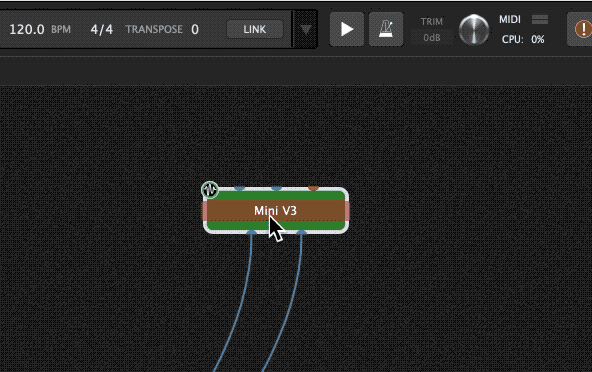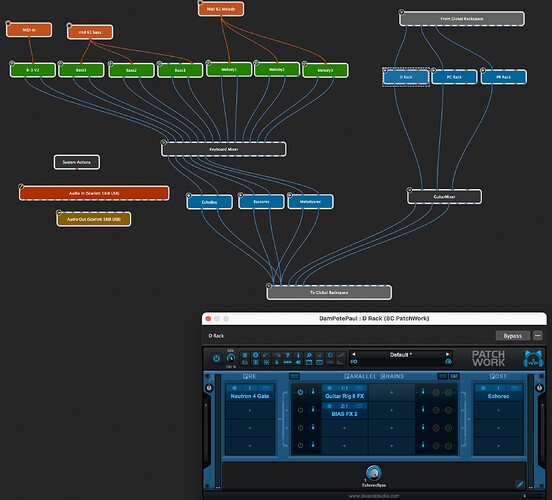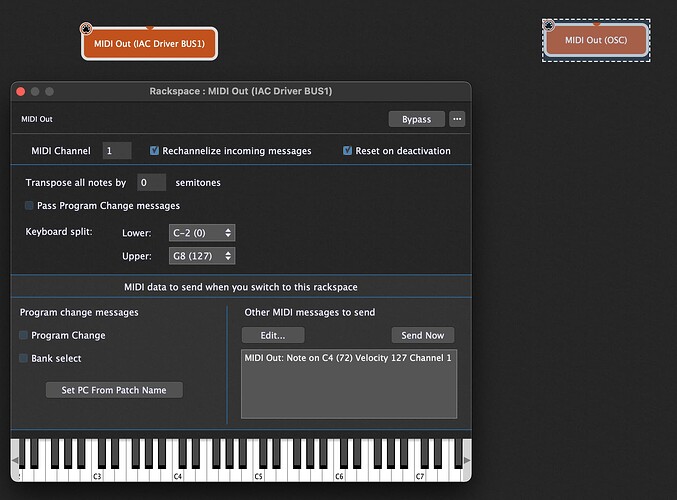I can try that, I just needed them until I figured out how to seperated the channels.
I am also curious, I have several like big band MIDI file with lots of horn parts, etc that far exceed 16 channel that my old set up allowed with128 channells of MIDI…will 25 to 30 channels of MIDI work you think?
You could create a 2nd instance of Gig Performer where you play your MIDI stuff.
This way latency does not matter.
And in the main instance you can play your live instruments.
I have a Focusrite 4i4 3rd gen. Did you check the power plans? You need to create/use a high performance power plan. That’s in the optimization guide as well.
This way I easily go to 192 samples. I additionally use Throttlestop. Then I can go to 64 samples.
How good is the audio interface device driver? Also, what computer is being used? Is it possible those channel strip VSTs just require more cycles than are available?
Hi Jeff,
as a newbie myself I completely missed that rack spaces are rack configurations and setlist is where songs and variations map to racks, I use both Windows desktop and Macbook, and I’ve noticed some crackles to my MOTU interface on Windows, I changed it from 44.1 to 48 and back, then it stopped, think it may have something to do with clock syncing between pc and card, I’ve not seen the problem on my MacBook to Focusrite.
Are you loading the audio files from an SSD drive or a normal drive, you don’t want any drive buffering going on.
are you using VST3 instead of VST1/2
I might be telling you how to suck eggs, but vst3 will stop consuming Cpu while in bypass, whereas vst1/2 will use them regardless.
beware of unpowered usb hubs, they work but not enough power can cause odd problems.
I had an issue with my roland vg99 because I was plugged into a USB3 port when it was a USB2 device, not all peripherals work well. on USB3 instead of USB2, I bought a usb2 PCIe card and it fixed the problem.
Are you using only the things you need in each Rackspace for a song?
Have you looked at ENTEC DMX Pro and EMU, using midi yoke on widows you can create virtual midi ports and map them to EMU for control of DMX.
Two screenshots of my setup.
“In theory there’s no difference between theory and practice, in practice there is”
— Yoggi Berra,
In other words, what you describe is supposed to be the way it works, but in real life it’s different.
I have numerous VST2s that not only stop consuming CPU cycles when bypassed but also do a very good job of reducing CPU cycles almost completely when they’re not actually making any sounds, even if they’re not bypassed

Welcome @Jeff312 to Gig Performer forum !
I second @DJAA suggestion on ENTEC for DMX… also to note GP has extensive OSC support ![]()
I had a custom pc built to my specifications - Widows 11 Pro, Intel i9-12900K 3.20GHz 12th Gen. 64.0 GB Ram. I run the GeForce EV3A graphics, two 32" monitors (TVs). I have 2 internal Samsung 980 Pro SSD Drives 1 TB each. I am running Windows version 22H2.
I currently run a Focusrite 8i6, 3rd gen interface running USB and MIDI, as well as an outboard 8 port MOTU MIDI interface. I run the real Asio. My DAW has 0% problems running anything I do. I think it is me and not speaking fluent GP yet.
Hi DJA,
I use only VST 3 devices to avoid any issues. I have two 1TB Samsun 980 Pro SSD Drives, very fast. m I using only things I need in rackspaces… I don’t know that yet, I am getting great info from folks here amd trying their suggestions. I run a powered USB hub, all hi speed ports. Your screen shot looks very nice, does the upper screen wiring tie into the llower screen wiring? That is what I am trying to do…I think.
![]() I have several nice DMX to MIDI interfaces, once I can get outside the box I am fine with that equipment.
I have several nice DMX to MIDI interfaces, once I can get outside the box I am fine with that equipment.
First thing I would do is to consider Frank’s suggestion here: Newbie to Gig Performer - #24 by Frank1119
yes both tied together, the mics are pretty fixed so in global and the guitars / keyboards in local rackspaces as they chage per song / variation
Yes I agree. I already downloaded that document and went through everything except the registry so far. So far everything I checked was done properly from my build specification, outside the registry of course. I’m quite sure there are some opportunities there as I was unaware of those changes when I put my spec together.
That is what I was calling “Linked”… clearly is not the correct terminology. But, that was what I was trying to figure out is how to pass MIDI and audio between the different rackspaces. But it sounds like only one rackspace can be active at a time. Are you running numerous “variations” in one rackspace and inter-connecting those? It makes perfect sense for the mics to be in Global. I put my guitar there as well as I have a setup that works for all my material and I just turn things on-off as needed.
There is always 1 variation of 1 rackspace active (and the global rackspace is always active). So the only interconnections that can exist are between the current rackspace and the global rackspace.
- For audio there are specialized input/output blocks.
- For midi, you would have to resort to OSC or something like that (enough topics about that on the forum).
- Connections between widgets and plugin parameters can also cross the boundary between current rackspace and the global rackspace (using the same input/output blocks)
Some clarification on the rackspace/variation terminology:
- A normal rackspace has always at least 1 variation
- A rackspace is a collection of plugins, the connections between the plugins, the connections to input/output blocks, the connections to midi-in/midi-out blocks and widgets
- These widgets serve as ‘memory’, or better, persistence of the parameter-of-a-plugin the widget is connected to
- Variations keep track of different settings of these widgets. Let’s say you’ve connected a switch-widget to the on/off parameter of a chorus plugin. Then you could have a variation with this widget turned on and another one with this widget turned off.
- Rackspaces and variations can be controlled (if desired) using program change messages
- A variation of a rackspace can be tied to a song part
- The global rackspace has no variations
When would you typically use variations: When you use (almost) the same plugins with the same connections and the settings of the plugins do not have to change, except for the parameters that are connected to widgets.
When would you typically use another rackspace: When you have to use a (very) different set of plugins or the routing between the plugins (or the midi-in/out ) is rather different.
My way of (humble) usage (I play electric guitar):
- I use 7 different rackspaces with just 1 variation for several guitar sounds ranging from clean to rather deep distorted.
- I use an additional rackspace with 3 variations for my bass-guitar. These variations differ in the eq settings and the used ‘cabinets’. The one I use depends on the element I use on the bass-guitar.
I use a second instance of GP for drumloops:
- 1 rackspace with 1 variation combined with songs in a songlist. The loops for the drums are loaded from disk using gpscript and gp-presets. The name of the song is the name of the preset to load. The different songparts trigger different drumloops for intro, chorus, verse, bridge, etcetera.
- For 1 particular song I need a midi-bass plugin to play a bass-line. This song is tied to a second rackspace (with this bass plugin and the midi-file player)
For now, however, I would stay away from multiple GP instances. Just focus on getting a grasp of the basics. The same could go when it comes to using gpscript.
Maybe this clarifies the relationships somewhat.
Hi Frank,
Thank you, this is much clearer now. I think I misunderstood what GP could do. I am not sure this is going to accomplish what I am tring to do. But your explanation made clear why many things I have been trying are not working properly ![]()


